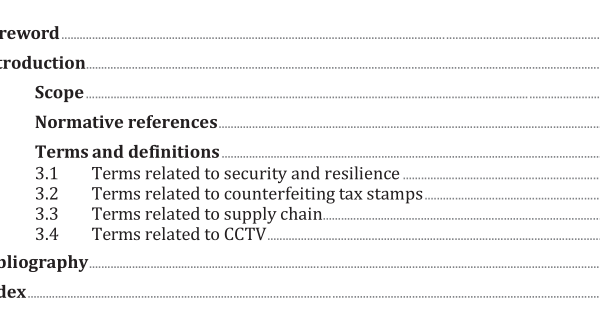ISO 22300:2021 pdf download – Security and resilience — Vocabulary.
3.1.6 alert part of public warning (3.1.197 ) that captures attention of first responders and people at risk (3.1.176) in a developing emergency (3.1.87 ) situation 3.1.7 all clear message or signal that the danger is over 3.1.8 all-hazards naturally occurring event (3.1.96), human induced event (both intentional and unintentional) and technology caused event with potential impact (3.1.118) on an organization (3.1.165), community (3.1.39) or society and the environment on which it depends 3.1.9 alternate worksite work location, other than the primary location, to be used when the primary location is not accessible 3.1.10 analysis area subject matter that has been selected to be peer reviewed (3.1.174) EXAMPLE Governance of risk management (3.1.224), assessment of risk, financial capacity, urban development, climate change adaptation and ecosystem protection, institutional capacity, community ( 3.1.39) and societal capacity, economic and business continuity (3.1.19), infrastructure (3.1.128), public health, recovering and rebuilding. 3.1.11 analysis system set of interconnecting parts that work together to form and deliver an analysis area (3.1.10) 3.1.12 area at risk location that could be affected by a disruptive event (3.1.76) (incident, accident, disaster) Note 1 to entry: The term is more relevant to preventative evacuations (3.1.92). 3.1.13 asset anything that has value to an organization (3.1.165) Note 1 to entry: Assets include but are not limited to human, physical, information (3.1.127), intangible and environmental resources (3.1.207 ). 3.1.14 audit systematic, independent and documented process (3.1.190) for obtaining audit evidence and evaluating it objectively to determine the extent to which the audit criteria are fulfilled Note 1 to entry: An audit can be an internal audit (3.1.134) (first party) or an external audit (second party or third party), and it can be a combined audit (combining two or more disciplines). Note 2 to entry: An internal audit is conducted by the organization ( 3.1.165) itself, or by an external party on its behalf. Note 3 to entry: “Audit evidence ” and “audit criteria ” are defined in ISO 19011. Note 4 to entry: The fundamental elements of an audit include the determination of the conformity (3.1.44) of an object (3.1.161) according to a procedure (3.1.189) carried out by personnel (3.1.179) not being responsible for the object audited.
Note 5 to entry: An internal audit can be for management ( 3.1.144) review (3.1.211) and other internal purposes and can form the basis for an organization’s declaration of conformity. Independence can be demonstrated by the freedom from responsibility for the activity (3.1.2) being audited. External audits include second- and third-party audits. Second-party audits are conducted by parties having an interest in the organization, such as customers, or by other persons on their behalf. Third-party audits are conducted by external, independent auditing organizations, such as those providing certification/registration of conformity or government agencies. Note 6 to entry: This constitutes one of the common terms and core definitions of the high level structure for ISO management system standards. The original definition has been modified by adding Notes 4 and 5 to entry. 3.1.15 auditor person who conducts an audit (3.1.14) [SOURCE: ISO 19011:2018, 3.15] 3.1.16 basic social services set of services delivered in education, health and social areas, as a means to fulfil basic needs 3.1.17 benefit measurable improvement resulting from the changes introduced as a result of a peer review (3.1.174) Note 1 to entry: Benefits can be tangible or intangible, quantifiable or non-quantifiable, and financial or non- financial. 3.1.18 biodiversity variability among living organisms from all sources including land, marine and other aquatic ecosystems (3.1.84) and the ecological complexes of which the organisms are part
ISO 22300:2021 pdf download – Security and resilience — Vocabulary






